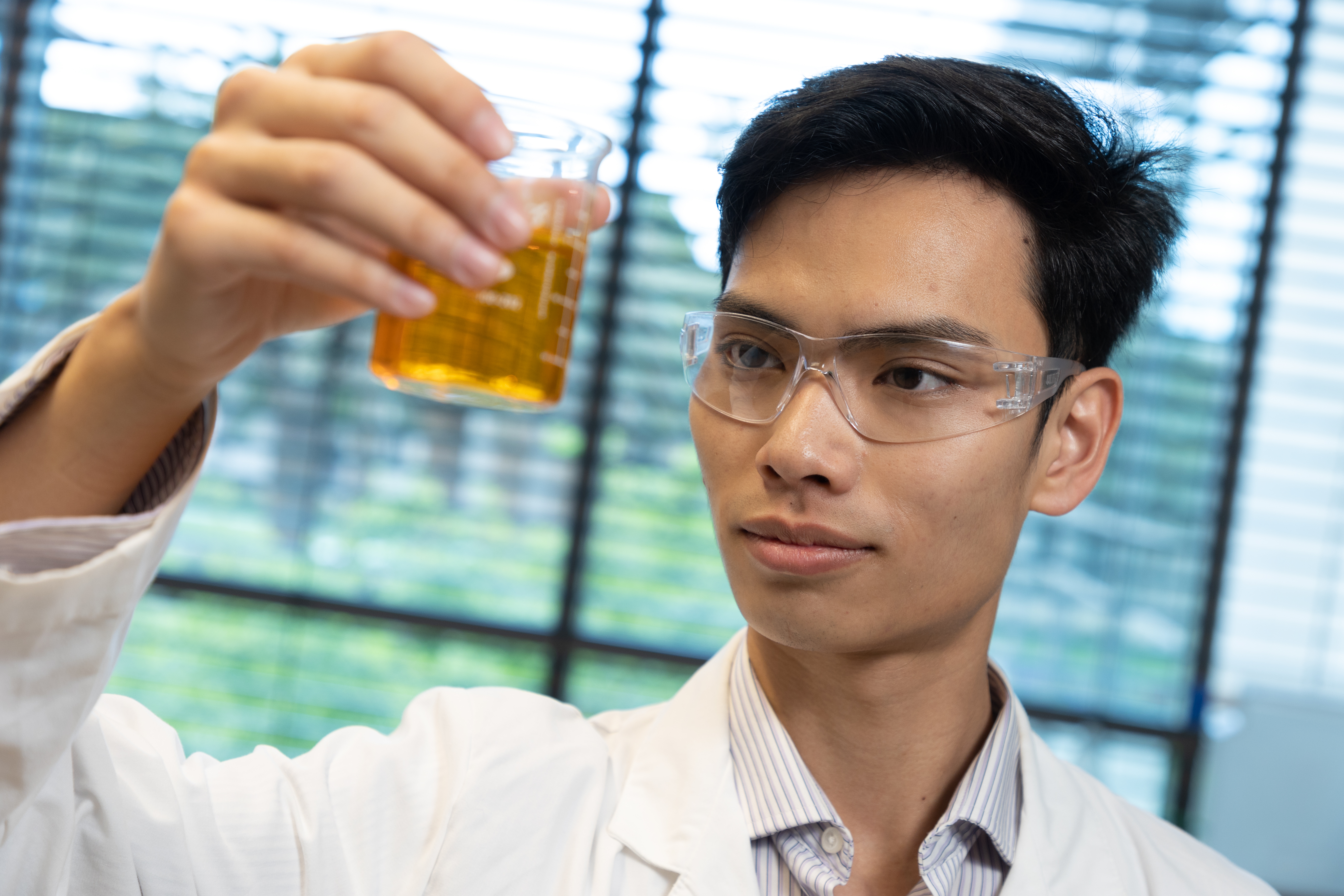
At Home in the Lab
An Doan ’24 is an exceptional student and LEAD Scholar with a drive to learn how things work. His unconventional, at times rocky road to Santa Clara is a testament to his perseverance.
When he isn’t in class, you’ll likely find An Doan ’24 hunkered down in his family’s San Jose home, running lab experiments out of a small work space in his kitchen or backyard. With his materials spread out over a table—scattered slabs of wood and power tools, potted plants placed under a heating lamp, and distilled essential oils—Doan works feverishly for days at a time, feeding his curiosity and testing endless ideas.
His junior year of high school, Doan assembled a Ruben’s tube, which is a device used in physics to visualize acoustic standing waves. The tube is sealed on both ends and lined at the top with tiny holes that allow flammable gas to flow through. A diaphragm and speaker are then attached to one end so that when the tube is lit, sound waves pass through, creating pressure differences and causing the flames to appear in a standing wave.
Why did Doan build it? He thought it was cool—and it is. Today, Doan’s former physics teacher at Willow Glen High School uses the tube for class demonstrations.
The next year, Doan built an aquaponic system for an independent research project in his environmental science class.
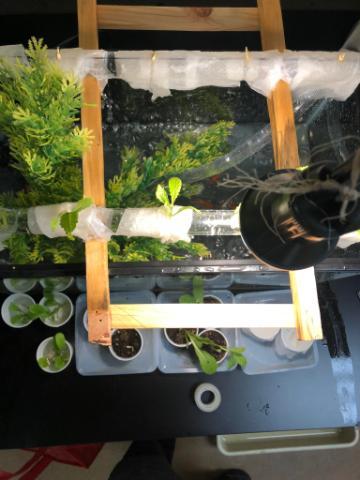
An created an aquaponic system in his home during his senior year of high school.
The system recycles fish waste and converts it into plant biomass. The experiment was a natural fit for Doan, who as the son of rural farmers from Vietnam, is “obsessed” with nature and enjoys gardening.
This summer, Doan, a biochemistry major, hopes to run distillation experiments that extract oils and compounds widely used in fragrances out of fruits and vegetables.
To the people who know him, these projects, among Doan’s many other accomplishments and extracurriculars, are quintessential Doan. He’s the real deal—someone who will find a way to change the world with his sharp intellect, kindness, and eagerness to learn, they say.
Finding His Place
Behind a jam-packed schedule and long list of extracurriculars is a desire to succeed. Doan immigrated to the U.S. from Vietnam at the age of 12. The youngest of six siblings, he is the first to attend a four-year university.
“I want to get the most out of my college experience,” says Doan, pointing out sacrifices his parents made to get him here. “I want to do as much as I can while I’m young and still have the time. Part of the reason why I do so much is because I really appreciate my parents. They worked really hard to get me here. I also just really enjoy learning.”
Things didn’t start off so smoothly for Doan. In fact, if you ask him, they started off terribly.
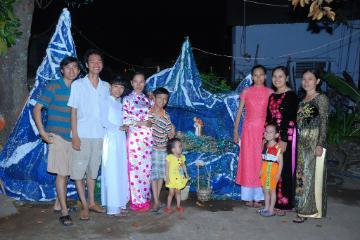
An Doan pictured with his family.
His story begins nearly 8,000 miles away, on a small paddy rice farm in the province of Dong Nai, where Doan grew up with his parents and five siblings. During harvest season, Doan would wake up before sunrise to help his parents pick rice, corn, and other vegetable crops before the heat intensified. The family would sell their harvest at a local market. Their earnings, though modest, kept them afloat. After school, Doan played in the street with neighbors, climbed the family’s many fruit trees or biked to a nearby hilltop overlooking the land his parents cultivated.
During corn season, the family slept in a thatched house on the field to keep close watch on their crops. They enjoyed freshly-plucked corn and roasted cashews under the moonlight, roasted in a fire pit that also served as a light source. There was no TV, no internet.
“All we had were some board games, a couple of comic books, a 100-year-old dimming incandescent light bulb, and a supply of electricity that very often needed to be replaced by candles,” recalls Doan. “It was a peaceful scene, the sound of leaves rubbing against one another, the gushes of winds, the peacefulness disrupted only by our laughter. The nights of January are cold and our only source of heat was the withering fire pit, yet I felt warm.”
Like many who choose to leave their home country for a better future, Doan’s parents ultimately decided to leave Vietnam to escape the political turmoil that remained even decades after the war. They wanted their children to have a better education and more professional opportunities. In search of a fresh start, they headed west to San Jose in 2014 where they could live closer to family.
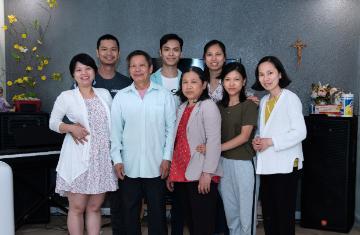
English didn’t come naturally for Doan and school wasn’t the most thrilling place, which meant he couldn’t keep up with most of his classes, often earning C’s and D’s in middle school. He remembers sitting bored in the back of social sciences class, working instead on math, science or ESL homework—and sometimes simply staring off into space—while the rest of the class followed a lesson plan.
That changed in eighth grade, when during a social studies class at Willow Glen Middle School, Doan’s teacher, Mrs. Ramos, asked the student next to him to find a particular passage in a textbook. To the teacher’s surprise, it was Doan who found it first. After that, Ramos asked him to follow along with the rest of the class.
“The way I did anything back then was to type things into Google translate into Vietnamese,” says Doan. “I didn’t have online textbooks back then so I had to use a physical copy. I literally spent hours typing in paragraph after paragraph of the textbook so that I could read it. That’s when I started learning a bit of English. I worked really hard just to prove to myself that I could do it. Eventually, I got an A in the class.”
That little bit of encouragement—the fact that Ramos actually saw him and what he was capable of inspired Doan to be better. That experience lit a fire in him that carried him into high school, where, with the help of other mentors, he took a series of AP classes, including chemistry, physics and environmental science, among others.
He credits his AP chemistry teacher, David Pratt, not only for making a difficult topic enjoyable, but pushing him academically and greatly influencing his decision to pursue science.
From there, his love for science—in particular chemistry—blossomed.
“It requires a lot of critical and logical thinking, which I’m really into,” says Doan. “I really like doing lab work because there’s so much to learn from it, and it doesn’t always go as planned. You have to figure things out. Not a lot of people can persevere through the whole process and get to the rewarding points.”
When it came time to apply for college, a close friend suggested Santa Clara. The school’s Jesuit values, paired with its intimate size and proximity to home, made it an ideal pick for Doan, who lives with several family members in San Jose.
Biochemistry and chemistry department Chair Amelia Fuller says Doan is always notably engaged and eager to learn. Or, as she puts it, to “get his hands dirty—but with gloves on.’”
“He’s in tune not only with the conceptual understanding of the class but also with how lab work reinforces that and how those skills complement and solidify the things that he’s learning in the classroom,” says Fuller. “That’s unique for students his age.”
For the last experiment of her organic chemistry lab class, Fuller challenged her students to improve the results of a chemical reaction they created earlier in the quarter by adjusting a number of variables—such as temperature—to increase the reaction’s efficiency. Doan and his lab partner chose to run two experiments in parallel so that they could explore differing variables and evaluate how each impacted their results.
“He was able to interpret the results from these to get a richer and deeper insight into our chemical reaction—his was the only group that endeavored to explore two variables rather than only the one I assigned,” says Fuller.
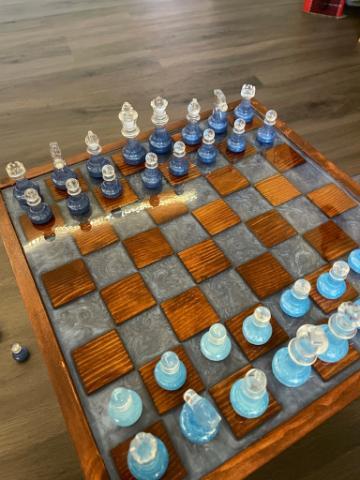
A chess board that An created in his home using resin.
When Ryan Benavente ’22 first met Doan last year, he remembers an introverted and quiet freshman who was still trying to find his footing at SCU. Doan had applied to be a member of Delta Epsilon Mu, Santa Clara’s co-ed fraternity for students interested in pursuing careers in medicine and health. Doan didn’t attend enough of the fraternity’s events that quarter, so he wasn’t invited to join. However, fraternity leaders encouraged him to reapply. By the next recruitment cycle, Doan had blossomed into a “completely changed applicant,” says Benavante. He was unanimously accepted into the organization, and Benavente became his big brother in the fraternity.
Doan’s genuine love for learning and ambition inspire him to pursue his own academic and professional goals, says Benavente.
“His drive and ambition is unparalleled,” Benavente says. “I know we have a mentoring relationship but he’s inspired me to push myself, to learn for the sake of learning and pursue things that I’m passionate about, not just because it will look good on my resume. I think that’s rare, to find people who can do that for you.”
Even as a mentor, Benavente has had little success slowing down Doan’s ambition. He remembers urging Doan to reconsider taking thermodynamics, a notoriously difficult class for upperclassmen that examines the relationship between heat and other forms of energy. At the time, Doan was already overloading on classes but wanted an opportunity to dive into a new, challenging topic.
After his pep talk, Benavente thought he had talked him out of enrolling in the class. But a few hours later he got a text from Doan: “I did it,” he wrote.
At Santa Clara, Doan assists associate professor of chemistry and biochemistry Steve Suljak in his research, learning how to identify cancer biomarkers in ovarian cancer. It may be a foreshadowing into his future: Doan hopes to go into the medical research field after graduation.
“My obsession with the lab is real,” Doan says, “and the human biological system is intriguing and complex enough to keep me interested in the field for the next five to six decades.”
An Doan '24 feels most at home in a lab.